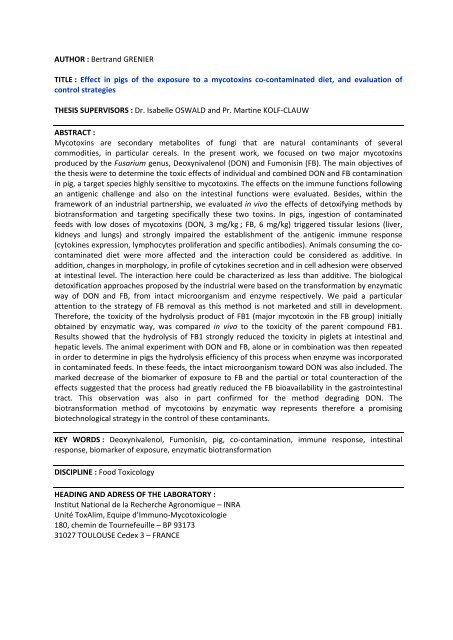Effet chez le porcelet d'une exposition à un régime co-contaminé en ...
Effet chez le porcelet d'une exposition à un régime co-contaminé en ...
Effet chez le porcelet d'une exposition à un régime co-contaminé en ...
You also want an ePaper? Increase the reach of your titles
YUMPU automatically turns print PDFs into web optimized ePapers that Google loves.
AUTHOR : Bertrand GRENIERTITLE : Effect in pigs of the exposure to a my<strong>co</strong>toxins <strong>co</strong>-<strong>co</strong>ntaminated diet, and evaluation of<strong>co</strong>ntrol strategiesTHESIS SUPERVISORS : Dr. Isabel<strong>le</strong> OSWALD and Pr. Martine KOLF-CLAUWABSTRACT :My<strong>co</strong>toxins are se<strong>co</strong>ndary metabolites of f<strong>un</strong>gi that are natural <strong>co</strong>ntaminants of several<strong>co</strong>mmodities, in particular cereals. In the pres<strong>en</strong>t work, we focused on two major my<strong>co</strong>toxinsproduced by the Fusarium g<strong>en</strong>us, Deoxyniva<strong>le</strong>nol (DON) and Fumonisin (FB). The main objectives ofthe thesis were to determine the toxic effects of individual and <strong>co</strong>mbined DON and FB <strong>co</strong>ntaminationin pig, a target species highly s<strong>en</strong>sitive to my<strong>co</strong>toxins. The effects on the imm<strong>un</strong>e f<strong>un</strong>ctions followingan antig<strong>en</strong>ic chal<strong>le</strong>nge and also on the intestinal f<strong>un</strong>ctions were evaluated. Besides, within theframework of an industrial partnership, we evaluated in vivo the effects of detoxifying methods bybiotransformation and targeting specifically these two toxins. In pigs, ingestion of <strong>co</strong>ntaminatedfeeds with low doses of my<strong>co</strong>toxins (DON, 3 mg/kg ; FB, 6 mg/kg) triggered tissular <strong>le</strong>sions (liver,kidneys and l<strong>un</strong>gs) and strongly impaired the establishm<strong>en</strong>t of the antig<strong>en</strong>ic imm<strong>un</strong>e response(cytokines expression, lymphocytes proliferation and specific antibodies). Animals <strong>co</strong>nsuming the <strong>co</strong><strong>co</strong>ntaminateddiet were more affected and the interaction <strong>co</strong>uld be <strong>co</strong>nsidered as additive. Inaddition, changes in morphology, in profi<strong>le</strong> of cytokines secretion and in cell adhesion were observedat intestinal <strong>le</strong>vel. The interaction here <strong>co</strong>uld be characterized as <strong>le</strong>ss than additive. The biologicaldetoxification approaches proposed by the industrial were based on the transformation by <strong>en</strong>zymaticway of DON and FB, from intact microorganism and <strong>en</strong>zyme respectively. We paid a particularatt<strong>en</strong>tion to the strategy of FB removal as this method is not marketed and still in developm<strong>en</strong>t.Therefore, the toxicity of the hydrolysis product of FB1 (major my<strong>co</strong>toxin in the FB group) initiallyobtained by <strong>en</strong>zymatic way, was <strong>co</strong>mpared in vivo to the toxicity of the par<strong>en</strong>t <strong>co</strong>mpo<strong>un</strong>d FB1.Results showed that the hydrolysis of FB1 strongly reduced the toxicity in pig<strong>le</strong>ts at intestinal andhepatic <strong>le</strong>vels. The animal experim<strong>en</strong>t with DON and FB, alone or in <strong>co</strong>mbination was th<strong>en</strong> repeatedin order to determine in pigs the hydrolysis effici<strong>en</strong>cy of this process wh<strong>en</strong> <strong>en</strong>zyme was in<strong>co</strong>rporatedin <strong>co</strong>ntaminated feeds. In these feeds, the intact microorganism toward DON was also included. Themarked decrease of the biomarker of exposure to FB and the partial or total <strong>co</strong><strong>un</strong>teraction of theeffects suggested that the process had greatly reduced the FB bioavailability in the gastrointestinaltract. This observation was also in part <strong>co</strong>nfirmed for the method degrading DON. Thebiotransformation method of my<strong>co</strong>toxins by <strong>en</strong>zymatic way repres<strong>en</strong>ts therefore a promisingbiotechnological strategy in the <strong>co</strong>ntrol of these <strong>co</strong>ntaminants.KEY WORDS : Deoxyniva<strong>le</strong>nol, Fumonisin, pig, <strong>co</strong>-<strong>co</strong>ntamination, imm<strong>un</strong>e response, intestinalresponse, biomarker of exposure, <strong>en</strong>zymatic biotransformationDISCIPLINE : Food Toxi<strong>co</strong>logyHEADING AND ADRESS OF THE LABORATORY :Institut National de la Recherche Agronomique – INRAUnité ToxAlim, Equipe d’Imm<strong>un</strong>o-My<strong>co</strong>toxi<strong>co</strong>logie180, chemin de Tournefeuil<strong>le</strong> – BP 9317331027 TOULOUSE Cedex 3 – FRANCE

















